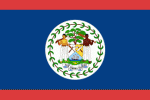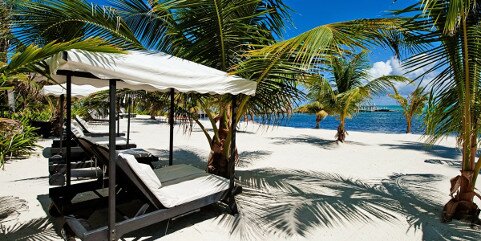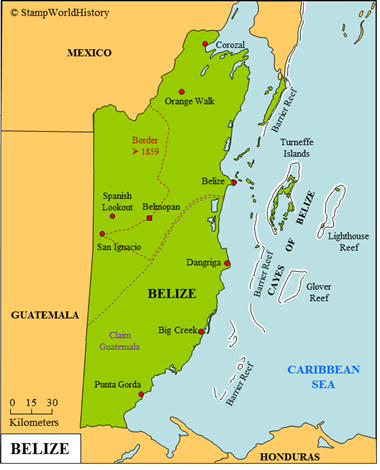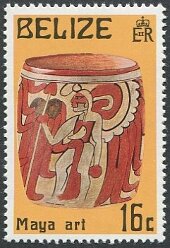
Belize
British colony

Belize
Independent
Quick reference
General issues: British colony/Self government 1973-1981, Independent within the British Commonwealth 1981-Present
Country name on general issues: Belize
Special issues: Regional issues Cayes of Belize 1984-1985
Currency: 1 Dollar = 100 Cent 1973-Present
Population: 132 000 in 1973, 332 000 in 2013
Political history Belize
Belize is located in Central America. Before colonization, Belize was inhabited by Amerindian peoples of Mayan descent. The Spanish explored the future Belize in 1524 and claimed it for Spain. Belize was made part of the Guatemala province of the Captaincy General of Guatemala. Although a Spanish possession, the British settled in Belize in 1638. Treaties with Spain in 1763, 1783 and 1786 legalized the settlements. In 1862, the settlements were made a British colony, that adopted the name British Honduras.
The borders of the British settlements had been defined by the 18th century treaties with Spain. The British, however, had settled well beyond these borders and, in 1834, claimed a substantially larger territory. A treaty was signed with Guatemala – the successor of Spain after it had gained independence in 1821 – in 1859 that established the borders as we know them today. In the treaty, Guatemala ceded the territory claimed by the British. As compensation the British would build a railroad connecting Guatemala to the Caribbean Sea through British Honduras. In 1940, Guatemala abrogated the agreement – based on the fact that the railroad had never been built by the British – and claimed the sovereignty over British Honduras.
In the 1930’s, the first steps were taken towards self government. The first general elections were held in 1954 and self government was achieved in 1964. Independence was delayed because of the ongoing conflict with Guatemala over the sovereignty over the country. The country, in 1973, adopted the name of Belize and gained independence within the British Commonwealth in 1981. In view of the Guatemalan claims, a contingent of the British army stayed in Belize. Guatemala would recognize the independence of Belize as a sovereign state in 1991 and diplomatic relations were established between the two countries. However, this would not end the dispute. Guatemala continues to claim the southern part of Belize until today. Belize has, since independence, been governed by democratically elected governments.

Tourism is a rapidly developing sector of the Belize economy.
From the earliest settlements until the mid 20th century, forestry was the mainstay of the Belize economy. In the 1950’s, the economy was diversified by the development of agriculture as an important sector in addition to forestry. Currently the economy is further diversified. Oil has overtaken agricultural products as the most important export product. Tourism is a rapidly developing sector. Belize ranks as a high development country on the United Nations Human Development index.
The population is mixed. The largest population group are the mestizos – people of mixed Amerindian and white origin – who account for 52% of the population. The second largest group are the creoles – people of mixed black and white origin – who account for 25% of the population. Amerindian peoples – Maya and Garifuna – account for 17% of the population.
Postal history Belize
The first stamps used in Belize were the general issues of Great Britain. These were used from 1858 at a post office the British had opened in 1857. British Honduras has issued stamps from 1866 and would issue stamps until 1973, when Belize issued its first stamps. In the 1970’s, and again from the 2000’s, the stamps issued by Belize are a blend of themes of national interest and themes aimed at the thematic collectors market. In the 1980’s and 1990’s, stamp production was almost entirely aimed at thematic collector. In 1984 and 1985, stamps were issued for the Cayes of Belize – the multitude of islands off the coast of Belize. These were valid throughout Belize although, probably aimed solely at the collectors market.
Album pages
← Previous page: BarbadosNext page: Bermuda →




The stamps of the Cayes of Belize were valid throughout the country.
William
Is there a resource I could refer too to confirm this? The catalogs make no mention of this.
“In 1984 the Belize Post Office started to issue stamps inscribed ‘Cayes of Belize’. Numerous examples exist around the world of stamps issued for a particular territory, yet valid for use anywhere in the ‘parent’ country; Scotland and Wales (UK) and Norfolk Island and Australian Antarctic Territory (Australia) are examples. However, the practice was not well received in the Cayes and the issues were discontinued after June 1985. Existing stocks were valid throughout Belize.”– http://www.bwisc.org/Publications/GSM_BWISC_articles_Belize.pdf (The quote is wrong about Norfolk Island but as this from a publication dealing with British Caribbean stamps I assume it is correct otherwise.)
William
Thanks for digging this up. I updated the profile. I hope you do not mind my asking for references: I am only trying to keep the quality of SWH at the highest possible level.